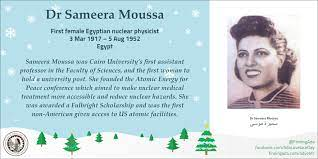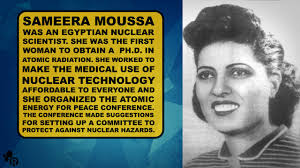Sameera Moussa, a remarkable scientist hailing from
Egypt..left an indelible mark on the scientific community with her
groundbreaking contributions. Her exceptional intellect, dedication, and
unwavering passion propelled her to the forefront of nuclear research during
the mid 20th century.
She was born just north of Cairo..
Egypt.. on March 3rd 1917. There isn’t much information on her childhood.. but we know her
mother died of ...Cancer when Sameera Moussa was young her
mother’s death would later inspire.. Sameera Moussa to study the use of
radiation for cancer treatments. ..After her mother’s passing . Sameera
Moussa and her father moved to Cairo, where her father established a hotel
business.
Some reports claim that Moussa’s father was a political activist, which may have inspired her later activism. Sameera Moussa exhibited extraordinary potential from an early age. Her relentless pursuit of knowledge led her to enroll at the University of Cairo, where she excelled in physics. Sameera Moussa's passion for nuclear science blossomed when she embarked on her doctoral studies at the University of Grenoble in France, specializing in the field of atomic radiation.
Sameera Moussa's ground-shaking breakthrough came in the early
1950's when she successfully discovered a method to produce cheap and accessible
nuclear energy. Her revolutionary technique, which utilized isotopes, promised
a future of abundant energy for the developing world. This remarkable
achievement earned her international acclaim and solidified her status as a
trailblazer in nuclear research.
Sameera Moussa was the first female Egyptian nuclear
scientist. She attended Cairo University, where she became the first woman to
earn a doctorate in atomic radiation and the first woman to hold a teaching
post. One of her goals was to make the medical use of nuclear technology
affordable to all people.
She is credited with saying, “I’ll make nuclear treatment as available and as cheap as Aspirin.” Sameera Moussa' promoted the peaceful use of nuclear technology and organized the Atomic Energy for Peace Conference.
Sameera Moussa's commitment to scientific progress
extended beyond her own achievements. She became a vocal advocate for the
peaceful use of nuclear energy and was instrumental in establishing the Atomic
Energy for Peace Conference in Geneva in 1955. Through this platform, she aimed
to foster international cooperation in harnessing the power of nuclear energy
for peaceful purposes, emphasizing its potential to eradicate poverty and
transform economies.
Back in Egypt, Sameera Moussa initiated the establishment of the Atomic Energy for Peace Association, which aimed to promote nuclear education and research within the country.
She played a crucial role in the construction of the
Atomic Energy Establishment in Cairo, a pioneering research facility that
facilitated further scientific advancements in Egypt.
Unfortunately, MSameera Moussa's groundbreaking research faced significant obstacles. The tumultuous political climate in Egypt during the 1950's and 60's hindered the realization of her ambitious plans for nuclear energy. International politics and the escalation of the Cold War placed restrictions on her efforts, and her work was shrouded in secrecy.
Thanks to her reputation, Sameera Moussa could travel to the UK in the mid-1940's, where she finished her PhD. There, she collaborated with several researchers to make further advancements in physics. With her colleagues, Sameera Moussa developed an equation that helped explain how to generate X-rays from cheaper metals like copper, which could help make medical imaging more affordable.
According to a 2022 Sameera Moussa’s research laid the groundwork for a revolution and the affordability and safety of nuclear medicine.”
Tragically, Sameera Moussa's life was cut short under mysterious circumstances in 1952. Her untimely death remains a subject of speculation, fueling conspiracy theories about the motives behind her demise. While her contributions were initially overshadowed, her legacy gradually emerged as a source of inspiration for aspiring scientists worldwide.
Due to the devastation of the atomic bombs, there was
widespread fear about nuclear power. To quell the hysteria, the US and UK
governments tried to spin a positive story. For example, they encouraged
scientists to host conferences, such as the PugWash Conferance in
Canada, where, for the first time since the war, scientists from the former
Allied and Axis countries came together to discuss the future of atomic weapons.
In addition, governments worldwide encouraged scientists to promote nuclear
benefits and avoid technical, scientific jargon, as it could create further
confusion among the public.
However, the Western world realized nuclear energy’s
potential power; it wanted to harness it and to keep its opponents from doing
so. To hide their intentions, the US and UK used “peaceful atom” as a political
tool to broker exclusive deals with countries that had uranium deposits, like
Brazil and South Africa.
In his book, The Wretched Atom.. Dr. Jacob Darwin Hamblin of Oregon State University writes that the idea of the
peaceful atom “took advantage of social aspirations, anxieties, and
environmental vulnerabilities, especially in the developing world.”
Because these deals often traded weapons for uranium,
associating the label “peaceful atom” with them was a complete sham. To avoid a
race for uranium, the US (and later the UK) downplayed its importance, citing
medicine and agriculture (like pest control or sterilization) as critical
benefits. Scientists who used the narrative of a “peaceful atom” provided cover
for the race for uranium and helped create a high-pressure and high-secrecy
environment within governmental research facilities around the globe as many
countries began stockpiling nuclear materials.
Sameera Moussa found herself amid this new arms race when she visited the United States in the early 1950's. Some accounts suggest she had been awarded one of the first Fulbright scholarships, but the organization has no record of her. In fact, it’s difficult to determine whether accounts of her time in the US have consistent details because the information is accurate, or because all of them simply echoed the same rumors.
She went to the University of Missouri to continue her research. From there, some accounts suggest Sameera Moussa connected with several researchers in California to tour some of their nuclear facilities. Sameera Moussa wrote in a letter to her father: “I have been able to visit nuclear plants in America, and when I come back to Egypt, I will be of great service to my country and be able to serve the cause of peace.”
Sameera Moussa's scientific brilliance and dedication
continue to inspire generations of scientists, particularly women, in Egypt and
beyond. Her audacity to explore unconventional avenues and her unwavering
commitment to the peaceful use of nuclear energy are beacons of inspiration.
In recognition of her groundbreaking work, the Egyptian
government established the Sameera Moussa Foundation for Scientific Research
and Development. This foundation serves as a testament to her enduring impact
and supports research endeavors across various scientific disciplines.
Furthermore, Sameera Moussa's legacy
has inspired numerous scholarships, awards, and programs aimed at fostering
scientific curiosity and nurturing talent in Egypt. “She was a
brilliant.. patriotic .. and Powerful Egyptian Woman”.. Through
these initiatives, her pioneering spirit lives on, empowering future scientists
to follow in her footsteps and make their mark in the scientific world.
Sameera Moussa's remarkable contributions to nuclear
science have cemented her status in the field. Despite the challenges she faced
during her lifetime






Comments
Post a Comment
thank you for watching